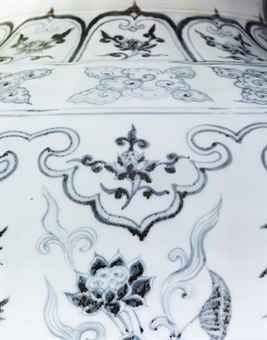An Important And Very Rare Early Ming Underglaze-Blue Baluster Jar,Guan. Hongwu Period (1368-1398)
An Important And Very Rare Early Ming Underglaze-Blue Baluster Jar, Guan. Hongwu Period (1368-1398). Photo Christie's Image Ltd 2012
The high shouldered jar with sharply tapered sides and waisted base stands on a heavy foot rim. The sides are potted with twelve lobed segments, each containing a long flowering branch growing from ornamental rocks; these include daylily, two varieties of lotus, pomegranate, tree peony, chrysanthemum, camellia, hibiscus, and rose blooms among others. These floral designs are set below a cloud collar lappet containing lotus sprays, and the waisted neck decorated with a band of clustered ruyi-cloud below a further band of upright lappets each enclosing a lotus. The tapered base is encircled by a keyfret band dividing lotus lappet borders containing further lotus blooms and stylised flower heads. The jar is supported on a wide foot encircled by a classic scroll and a recessed base. 20 7/8 in. (53 cm.) high. Estimate HK$6,000,000 - HK$8,000,000 ($777,796 - $1,037,061)
Notes: There are a number of variations of this pattern either decorated in underglaze-blue or underglaze-red. Whilst most of these jars appear with restored necks where the luting line joins the body and neck, the present jar is remarkable to have survived nearly intact.
Two very similar excavated covered jars are published: the first, excavated from the Haidian district of Beijing in 1961, included in the exhibition, The Genius of China, illustrated by W. Watson, Catalogue, 1973, p. 157, no. 364; and the other, discovered at Dongmentou, Zhushan, was exhibited in Imperial Hongwu and Yongle Porcelain Excavated at Jingdezhen, Chang Foundation, Taipei, 1996, illustrated in the Catalogue, no. 1. It has been suggested that the form was derived from the archaic storage vessel, lei, op. cit., p. 68. A third near-identical jar, missing its neck at the uppermost luting line, is illustrated in Blue and White Porcelain with Underglazed Red (I), The Complete Collection of Treasures of the Palace Museum, Hong Kong, 2000, pl. 13.
The style of the present jar is closely related to the blue and white jar with a restored neck sold at Sotheby's Hong Kong, 30 April 1991, lot 9, and offered at Sotheby's Hong Kong, 9 October 2012, lot 3060. Compare to other published examples of this pattern in underglaze-red: one in the Matsuoka Museum of Art, illustrated in Selected Masterpieces of Oriental Ceramics, Japan, 1983, pl. 44; another in the Baur Collection, illustrated by J. Ayers, Chinese Ceramics in the Baur Collection, vol. 1, Geneva, 1999, pl. 59 [A136]; and the jar sold at Christie's Hong Kong, The Imperial Sale, 26 April 1999, lot 551.
Christie's. Important Chinese Ceramics and Works of Art. 28 November 2012. Hong Kong

/https%3A%2F%2Fprofilepics.canalblog.com%2Fprofilepics%2F1%2F0%2F100183.jpg)
/https%3A%2F%2Fstorage.canalblog.com%2F03%2F02%2F119589%2F96711876_o.jpg)
/https%3A%2F%2Fstorage.canalblog.com%2F11%2F31%2F119589%2F94773502_o.jpg)
/https%3A%2F%2Fstorage.canalblog.com%2F20%2F83%2F119589%2F94772815_o.jpg)
/https%3A%2F%2Fstorage.canalblog.com%2F26%2F72%2F119589%2F75604929_o.jpg)
/https%3A%2F%2Fstorage.canalblog.com%2F59%2F60%2F119589%2F26458628_o.jpg)




/http%3A%2F%2Fstorage.canalblog.com%2F24%2F10%2F119589%2F128258452_o.jpg)
/http%3A%2F%2Fstorage.canalblog.com%2F63%2F94%2F119589%2F128246772_o.jpg)
/http%3A%2F%2Fstorage.canalblog.com%2F44%2F15%2F119589%2F126944801_o.jpg)
/http%3A%2F%2Fstorage.canalblog.com%2F19%2F02%2F119589%2F126125366_o.jpg)